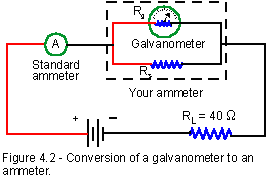
Physics 212 Lab 7
Meters
Purpose
To use a galvanometer whose full-scale current is known and internal resistance
is known with the proper additional resistances as calculated from Ohm's law
to convert the galvanometer first to a 100 mA fullscale ammeter and then to
a 5 V full-scale voltmeter.
Equipment
Galvanometer with a full scale reading of 500 m
A (0.5 mA), a decade resistance box, resistance wire, standard ammeter
and voltmeter, switch, wires and power supply.
Theory
A galvanometer is an instrument for detecting small currents. It consists
essentially of a coil of fine wire mounted so that it can rotate in the
field of a permanent magnet. When current flows through the coil, the resulting
magnetic force on the coil windings creates a torque on the coil that makes
it rotate until equilibrium is established between the torque on the coil
and that exerted by a restoring spring. The angle of rotation of the coil
thus will depend on the current flowing through coil and a needle attached
to coil can be calibrated to give the current. (In many designs, the angle
of rotation of the coil is linearly proportional to the current, but for
the galvanometer used in this lab you will note that this is not quite the
case.)
A typical analog ammeter consists of a sensitive galvanometer with a low
resistance called a shunt connected in parallel with it. The shunt allows
currents to flow through the ammeter that would otherwise burn out the galvanometer.
The shunt also allows the ammeter to have a low resistance so that it will
have a small effect on the circuit whose current is to be measured. (To use
an ammeter the circuit must be broken and the ammeter inserted between the
break.)
A typical analog voltmeter consists of a sensitive galvanometer connected
in series with a resistance known as a multiplier. Since a voltmeter is
placed in parallel with the voltage to be measured, it should have a high
resistance so that it does not appreciably alter the circuit being measured.
The range or full-scale reading of an ammeter or voltmeter can be changed
by changing the shunt or multiplier resistor. From a knowledge of the full-scale
galvanometer current Ig, the galvanometer resistance Rg
, and the desired range of the meter, the needed shunt or multiplier resistance
can be easily calculated by means of Ohm's law.
Procedure
Part I Conversion of your galvanometer to an ammeter with a full scale
reading of 100 mA.
In an ammeter the same voltage is across both the shunt resistor and the
galvanometer. Use this fact and Ohm's law to calculate the value for a shunt
resistor Rs that will make an ammeter with a full-scale reading
of 100 mA.
Using resistance wire with linear resistance supplied by your instructor
and cut a piece of wire long enough to give Rs plus a little
extra to allow connections to be made at the galvanometer binding posts.
Wire your ammeter into the circuit shown in Figure 4.2. For your load
resistor RL set the decade box to 40 W
.

Slowly vary the power supply voltage from zero to several volts so that your ammeter reads from zero to 100 mA. Make a calibration curve for your ammeter by plotting the readings of your ammeter versus the readings of the standard Ammeter.
Part II Conversion of your Galvanometer to a voltmeter with a full-scale
reading of 5 V.
Use Ohm's law to calculate the value of the multiplier resistor that must be in series with your galvanometer resistance Rg to give full-scale deflection, Ig, when the voltage applied to the series combination is 5 V.
Wire the circuit as in Figure 4.3, using a decade box for the necessary
multiplier resistance, Rm:

By varying the applied voltage V of the power supply, plot a calibration
curve as in Part II of your voltmeter versus the standard voltmeter.
Answer the following questions and include with your report:
1. What is the resistance for an ideal ammeter?
2. What would be the resistance of an ideal voltmeter?
3. Given an ammeter with a full-scale range of 1 Amp and an internal resistance
of 100 W, what shunt resistance is needed to
increase its range to 100 Amp?
Your write should contain a description of perfect ammeters, voltmeters and how they need to be connected in a circuit; How to construct ammeters and voltmeters using Kirchoffs rules; How to obtain to make a resistance of specific value using a wire (describe how resistance depends on length, cross sectional area and resistivity), and calibration graphs and tables.